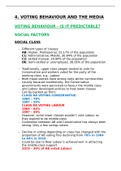Summary
Summary Voting Behaviour and the Media Edexcel A-Level politics
- Institution
- PEARSON (PEARSON)
Detailed summary notes of the whole fourth topic in Paper one of Edexcel A-Level politics. Essay plans, detailed explanations and informed examples will make you feel reassured for your exam
[Show more]



